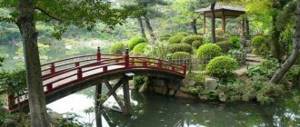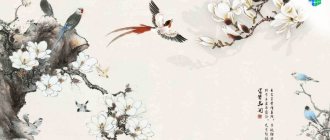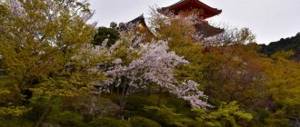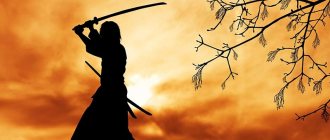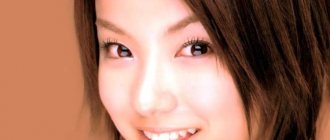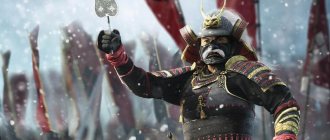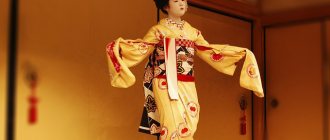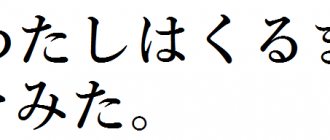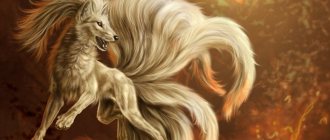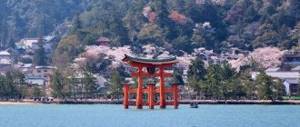Features of haiku
Haiku is a lyric poem.
It depicts the life of nature and the life of man in their fused, indissoluble unity against the backdrop of the cycle of the seasons. The rhythm of Japanese poetry is based on the alternation of a certain number of syllables. There is no rhyme, but the sound and rhythmic organization of the tercet is a subject of great concern to Japanese poets.
Haiku has a stable meter. Each verse has a certain number of syllables: five in the first, seven in the second and five in the third - a total of seventeen syllables. This does not exclude poetic license, especially among such bold and innovative poets as Matsuo Basho (1644-1694). He sometimes did not take into account the meter, striving to achieve the greatest poetic expressiveness.
Some features of haiku can only be understood by becoming familiar with its history.
Precise boundaries of the seasons were developed and the seasonality of one or another natural phenomenon was clearly defined. Even standard “seasonal words” appeared, which conventionally denoted always the same season of the year and were no longer used in poems describing other seasons. It was enough, for example, to mention the word “haze”, and everyone understood that we were talking about the foggy time of early spring.
The number of such seasonal words reached three to four thousand. Thus, words and combinations of words: plum blossoms, nightingale, cobweb, cherry and peach flowers, lark, butterfly, digging up a field with a hoe and others - indicated that the action takes place in the spring. Summer was designated by the words: downpour, cuckoo, planting rice seedlings, flowering paulownia, peony, weeding rice, heat, coolness, midday rest, mosquito canopy, fireflies and others.
The words indicating autumn were: moon, stars, dew, the cry of cicadas, harvesting, Bon holiday, red maple leaves, flowering hagi bush, chrysanthemums. Winter words are drizzling rain, snow, frost, ice, cold, warm clothes on cotton wool, hearth, brazier, end of the year.
"Long day" meant a spring day because it seems especially long after the short days of winter. “Moon” is an autumn word because in autumn the air is especially clear and the moon shines brighter than at other times of the year.
Sometimes the season was still called for clarity: “spring wind”, “autumn wind”, “summer moon”, “winter sun” and so on.
Matsuo Basho
* * * In my cramped hut, the Moon illuminated all four corners, looking through the window.
A short rest in a hospitable home
Here I will finally throw into the sea my storm-worn hat and my torn sandals.
* * *
Suddenly you will hear “shorkh-shorkh”. Longing stirs in my soul... Bamboo on a frosty night.
In a foreign land
A thin tongue of fire - The oil in the lamp has frozen. You wake up... What sadness!
* * *
Wandering Raven, look! Where is your old nest? Plum trees are in bloom everywhere.
* * *
The oncoming mountain resident did not open his mouth. The grass reaches his chin.
* * *
We looked at the moon. Finally we can breathe! - A fleeting cloud.
* * *
How the autumn wind whistles! Then only you will understand my poems, When you spend the night in the field.
* * *
And in the fall this butterfly wants to live: it quickly drinks the dew from the chrysanthemum.
* * *
The flowers have faded. Seeds are pouring and falling, like tears...
* * *
The impetuous leaflet hid in a grove of bamboo and gradually calmed down.
For the New Year
How many snows have already been seen, But their hearts have not changed. The branches of the pine trees are green!
In memory of a friend
Take a close look! You will see the flowers of the “shepherd’s purse” under the fence.
Looking out the window after illness
The Kannon Temple is there, in the distance, The tiled roof is red In the clouds of cherry blossoms.
* * *
They fly to the ground and return to their old roots. Separation of flowers!
* * *
Old Pond A frog jumped into the water. A splash in silence.
* * *
Oh, wake up, wake up! Become my comrade. Sleeping moth!
To a friend who left for the western provinces
West, East - The same trouble is everywhere, The wind is equally cold.
I walk around the pond
Autumn Moon Festival. Around the pond, and around again, All night long all around!
Grain storage jug
That's all I'm rich with! Light, like my life, gourd pumpkin.
* * *
Only you, the peddler of winter colza, remained faithful to this grass-covered Hut.
* * *
The first snow is in the morning. He barely bent down the daffodil leaves.
* * *
The water is so cold! The seagull cannot sleep, rocking on the wave.
* * *
The jug burst with a crash: At night the water in it froze. I woke up suddenly.
* * *
New Year's market in the city. And I would like to visit it at least once! Buy smoking sticks.
* * *
Hey shepherd boys! Leave some branches to the plum tree, cutting off the vines.
* * *
The moon or the morning snow... Admiring the beauty, I lived as I wanted. This is how I end the year.
To a leaving friend
Friend, don’t forget Hidden invisibly in the thicket of Plum blossom!
* * *
Seaweed is lighter... And the old merchant carries a basket of heavy oysters on his shoulder.
* * *
Clouds of cherry blossoms! The ringing of the bell reached... From Ueno or Asakusa? *
My perception of haiku
Beauty can be deeply hidden.
In haiku poems I find a new, social rethinking of this truth - the affirmation of beauty in the unnoticed, the ordinary, and above all in the common man of the people. This is precisely the meaning of the poem by the poet Kikaku:
Cherries in spring blossom Not on the distant mountain tops - Only in our valleys.
True to the truth of life, the poets could not help but see the tragic contrasts in feudal Japan. They felt the discord between the beauty of nature and the living conditions of the common man. Basho’s haiku speaks about this discord:
Next to the blooming bindweed, the thresher is resting during the harvest. How sad it is, our world!
And like a sigh escapes Issa:
Sad world! Even when the cherry blossoms... Even then...
The anti-feudal sentiments of the townspeople found an echo in haiku. Seeing a samurai at the cherry blossom festival, Kyorai says:
How is this, friends? A man looks at the cherry blossoms, And on his belt is a long sword!
The people's poet, a peasant by birth, Issa asks the children:
Red Moon! Who owns it, children? Give me an answer!
And children will have to think about the fact that the moon in the sky, of course, is no one’s and at the same time common, because its beauty belongs to all people.
The book of selected haiku contains the entire nature of Japan, its original way of life, customs and beliefs, the work and holidays of the Japanese people in their most characteristic, living details.
That is why, I believe, haiku is loved, known by heart and still composed to this day.
We must, however, remember that Japanese tercet necessarily requires the reader to work with imagination and participate in the creative work of the poet. In my opinion, this is the main feature of haiku. To explain everything to the end means not only to sin against Japanese poetry, but also to deprive the reader of the great joy of growing flowers from a handful of seeds generously scattered by Japanese poets.
Haiku and their creators
The tercet was firmly established in Japanese poetry and acquired its true capacity in the second half of the seventeenth century. It was raised to unsurpassed artistic heights by the great Japanese poet Matsuo Basho, the creator of not only haiku poetry, but also an entire aesthetic school of Japanese poetics.
Even now, after three centuries, every cultured Japanese knows Basho’s poems by heart. A huge research literature has been created about them, testifying to the close attention of the people to the work of their national poet.
Basho revolutionized haiku poetry. Seasonal words became poetic images for him, full of deep meaning.
Basho's lyrics reveal to us the world of his poetic soul, his feelings and experiences, but there is no intimacy or isolation in his poems. The lyrical hero of Basho's poetry has specific characteristics. This is a poet and philosopher, in love with the nature of his native country, and at the same time - a poor man from the outskirts of a big city. And he is inseparable from his era and people. In every little haiku of Basho one can feel the breath of a vast world. These are sparks from a big fire.
To understand Basho's poetry, familiarity with his era is necessary. The best period of his work was during the Genroku years (late seventeenth century). The Genroku period is considered the “golden age” of Japanese literature. Basho knew well the life of ordinary people in Japan.
The poet’s words should not be taken too literally; rather, they sound like a challenge to imitators who, blindly following ready-made models, began to compose poems in abundance with pretensions to profundity. Basho's late poems are by no means petty; they are distinguished by their high simplicity, because they talk about simple human affairs and feelings. Poems become light, transparent, fluid. They show subtle, kind humor, warm sympathy for people who have seen a lot and experienced a lot. The great humanist poet could not isolate himself in the conventional world of sublime poetry of nature. Here is a picture from peasant life:
The boy perched on the saddle, and the horse was waiting. Collect radishes.
But the city is preparing for the New Year holiday:
Sweep away the soot. For himself, this time the Carpenter gets along with the shelf.
The subtext of these poems is a sympathetic smile, and not mockery, as was the case with other poets. Basho does not allow himself any grotesqueries that distort the image.
Basho walked along the roads of Japan as an ambassador of poetry itself, igniting in people a love for it and introducing them to true art. He knew how to find and awaken the creative gift even in a professional beggar. Basho sometimes penetrated into the very depths of the mountains, where “no one will pick up a fallen wild chestnut fruit from the ground,” but, valuing solitude, he was never a hermit. In his travels, he did not run away from people, but became close to them. A long line of peasants working in the fields, horse drivers, fishermen, and tea leaf pickers pass through his poems.
Basho captured their sensitive love for beauty. The peasant straightens his back for a moment to admire the full moon or listen to the cry of the cuckoo, so beloved in Japan.
Images of nature in Basho's poetry very often have a secondary meaning, allegorically speaking about man and his life. A scarlet pepper pod, a green chestnut shell in autumn, a plum tree in winter are symbols of the invincibility of the human spirit. An octopus in a trap, a sleeping cicada on a leaf, carried away by a stream of water - in these images the poet expressed his feeling of the fragility of existence, his thoughts about the tragedy of human fate.
As Basho's fame grew, students of all ranks began to flock to him. Basho passed on his teachings about poetry to them. From his school came such wonderful poets as Boncho, Kyorai, Kikaku, Joso, who adopted a new poetic style (Basho style).
On the way I got sick, And my dream keeps running and circling through the scorched meadows.
Basho's poetry is distinguished by a sublime system of feelings and at the same time amazing simplicity and truth of life. There were no base things for him. Poverty, hard work, the life of Japan with its bazaars, taverns on the roads and beggars - all this was reflected in his poems. But the world remains beautiful for him.
There may be a wise man hidden in every beggar. The poet looks at the world with loving eyes, but the beauty of the world appears before his gaze shrouded in sadness.
For Basho, poetry was not a game, not amusement, not a means of subsistence, as for many contemporary poets, but a high calling throughout his life. He said that poetry elevates and ennobles a person.
Among Basho's students there were a variety of poetic personalities.
Kikaku, an Edo townsman and happy-go-lucky reveler, sang the praises of the streets and rich shops of his hometown:
With a crash, silks are torn in Echigoya's shop... Summer time has come!
The poets Boncho, Joso, each with their own special creative style, and many others belonged to the Basho school. Kyorai from Nagasaki, together with Boncho, compiled the famous haiku anthology “The Straw Cloak of the Monkey” (“Saru-mino”). It was published in 1690.
At the beginning of the eighteenth century, the poetic genre of haiku fell into decline. Buson, a wonderful poet and landscape artist, breathed new life into it. During his lifetime, the poet was almost unknown; his poems became popular only in the nineteenth century.
Buson's poetry is romantic. Often in three lines of a poem he could tell an entire story. Thus, in the poem “Changing clothes with the onset of summer” he writes:
They hid from the master's sword... Oh, how glad the young spouses are to change their winter dress with a light dress!
According to feudal orders, the master could punish his servants with death for “sinful love.” But the lovers managed to escape. The seasonal words “a change of warm clothes” well convey the joyful feeling of liberation on the threshold of a new life.
In Buson’s poems the world of fairy tales and legends comes to life:
The fox turned into a young nobleman... The spring wind.
Foggy evening in spring. The moon shines dimly through the haze, cherry trees are blooming, and in the semi-darkness fairy-tale creatures appear among people. Buson only draws the outlines of the picture, but the reader is confronted with a romantic image of a handsome young man in an ancient court attire.
Buson often resurrected images of antiquity in poetry:
The hall for overseas guests is fragrant with mascara... White plums in bloom.
This haiku takes us deep into history, into the eighth century. Special buildings were then built to receive “overseas guests.” One can imagine a poetry tournament in a beautiful old pavilion. Guests arriving from China write Chinese poems with fragrant ink, and Japanese poets compete with them in their native language. It is as if a scroll with an ancient picture is unfolding before the reader’s eyes.
Buson is a poet of wide range. He willingly draws the unusual: a whale in the sea, a castle on a mountain, a robber at the turn of a highway, but he also knows how to warmly draw a picture of a child’s intimate world. Here is the tercet “At the Doll Festival”:
A short-nosed doll... It’s true that when she was a child, her mother pulled her little by the nose!
But in addition to “literary poems”, rich in reminiscences, allusions to antiquity, and romantic images, Buson knew how to create poems of amazing lyrical power using the simplest means:
They passed, the days of spring, When distant Nightingale voices sounded.
Issa, the most popular and democratic of all the poets of feudal Japan, created his poems at the end of the eighteenth and beginning of the nineteenth centuries, at the dawn of modern times. Issa came from a village. He spent most of his life among the urban poor, but retained his love for his native places and peasant labor, from which he was cut off:
With all my heart I honor, Resting in the midday heat, People in the fields.
In these words, Issa expressed both his reverent attitude towards the peasant’s work and his shame at his forced idleness.
Issa's biography is tragic. All his life he struggled with poverty. His beloved child died. The poet spoke about his fate in verses full of aching mental pain, but a stream of folk humor also breaks through them. Issa was a man with a big heart: his poetry speaks of love for people, and not only for people, but for all small creatures, helpless and offended. Watching a funny fight between frogs, he exclaims:
Hey, don't give in, Skinny Frog! Issa for you.
But at times the poet knew how to be harsh and merciless: he was disgusted by any injustice, and he created caustic, prickly epigrams.
Issa was the last major poet of feudal Japan. Haiku lost its importance for many decades. The revival of this form at the end of the nineteenth century already belongs to the history of modern poetry. The poet Masaoka Shiki (1867-1902), who wrote many interesting works on the history and theory of haiku (or in his terminology now accepted in Japan - haiku), and his talented students Takahama Kyoshi and Kawahigashi Hekigodo revived the art of haiku on a new, realistic basis .
Nowadays, the popularity of tercets has increased even more. Haiku are constantly published on the pages of magazines and newspapers. Such poems are living responses to the events of the day. They contain the voice of the Japanese people.
A collection was also published in Russian, which included only haiku of the late Middle Ages: from Basho to Issa.
The translator faced great difficulties. Ancient haiku is not always understandable without commentary, even to a Japanese reader who is well acquainted with the nature and life of his native country. Brevity and reticence lie at the very basis of haiku poetics. The translator sought to preserve the laconicism of haiku and at the same time make them understandable.
The dimensions of haiku are so small that in comparison with it a European sonnet seems monumental. It contains only a few words, and yet its capacity is relatively large. The art of writing haiku is, first of all, the ability to say a lot in a few words. Brevity makes haiku similar to folk proverbs. Some tercets have gained currency in popular speech as proverbs, such as the poem by the poet Basho:
I’ll say the word - my lips turn cold. Autumn whirlwind!
As a proverb, it means that “caution sometimes makes one remain silent.”
But most often, haiku differs sharply from the proverb in its genre characteristics. This is not an edifying saying, a short parable or a well-aimed wit, but a poetic picture sketched in one or two strokes. The poet’s task is to infect the reader with lyrical excitement, to awaken his imagination, and for this it is not necessary to paint a picture in all its details.
This method of depiction requires maximum activity from the reader, draws him into the creative process, and gives impetus to his thoughts. You cannot skim through a collection of haiku, flipping through page after page. If the reader is passive and not attentive enough, he will not perceive the impulse sent to him by the poet.
Some poets, and first of all Issa, whose poetry most fully reflected the people's worldview, lovingly depicted the small and weak, asserting their right to life. When Issa stands up for a firefly, a fly, a frog, it is not difficult to understand that by doing so he stands up for the defense of a small, disadvantaged person who could be wiped off the face of the earth by his master, the feudal lord.
Thus, the poet’s poems are filled with social sound.
Now the moon has come out, And every small bush is invited to the holiday, -
says Issa, and we recognize in these words the dream of equality of people.
Giving preference to the small, haiku sometimes painted a picture of a large scale:
The sea is raging! Far away, to Sado Island, the Milky Way spreads.
This poem by Basho is a kind of peephole. Leaning our eyes towards it, we will see a large space. The Sea of Japan will open before us on a windy but clear autumn night: the sparkle of stars, white breakers, and in the distance, at the edge of the sky, the black silhouette of Sado Island.
Or take another Basho poem:
There are pine trees on a high embankment, And between them there are cherries, and a palace In the depths of flowering trees...
In three lines there are three perspective plans.
Haiku is akin to the art of painting. They were often painted on the subjects of paintings and, in turn, inspired artists; sometimes they turned into a component of the painting in the form of a calligraphic inscription on it. Sometimes poets resorted to methods of depiction akin to the art of painting. This is, for example, Buson’s tercet:
Crescent flowers around. The sun is going out in the west. The moon is rising in the east.
Wide fields are covered with yellow colza flowers, they seem especially bright in the sunset. The pale moon rising in the east contrasts with the fiery ball of the setting sun. The poet does not tell us in detail what kind of lighting effect is created, what colors are on his palette. He only offers a new look at the picture that everyone has seen, perhaps, dozens of times... Grouping and selection of pictorial details is the main task of the poet. He has only two or three arrows in his quiver: not one should fly past.
This laconic manner is sometimes very reminiscent of the generalized method of depiction used by the masters of color engraving ukiyoe. Different types of art - haiku and color engraving - are marked by the features of the general style of the era of urban culture in Japan of the seventeenth and eighteenth centuries, and this makes them similar to each other.
Spring rain is pouring! Along the way, Umbrella and Mino talk.
This Buson tercet is a genre scene in the spirit of ukiyoe engraving. Two passers-by are talking on the street under the net of spring rain. One is wearing a straw cloak - mino, the other is covered with a large paper umbrella. That's all! But the poem feels the breath of spring, it has subtle humor, close to the grotesque.
Often the poet creates not visual, but sound images. The howl of the wind, the chirping of cicadas, the cries of a pheasant, the singing of a nightingale and a lark, the voice of a cuckoo - each sound is filled with a special meaning, giving rise to certain moods and feelings.
A whole orchestra sounds in the forest. The lark leads the melody of the flute, the sharp calls of the pheasant lead the percussion instrument.
The lark sings. The pheasant echoes him with a ringing blow in the thicket. (Basho)
The Japanese poet does not unfold before the reader the entire panorama of possible ideas and associations that arise in connection with a given subject or phenomenon. It only awakens the reader’s thought and gives it a certain direction.
A raven sits alone on a bare branch. Autumn evening. (Basho)
The poem looks like a monochrome ink drawing. Nothing extra, everything is extremely simple. With the help of a few skillfully chosen details, a picture of late autumn is created. You can feel the absence of wind, nature seems frozen in sad stillness. The poetic image, it would seem, is slightly outlined, but it has great capacity and, bewitching, takes you along.
It seems that you are looking into the waters of a river, the bottom of which is very deep. And at the same time, he is extremely specific. The poet depicted a real landscape near his hut and, through it, his state of mind. He is not talking about the raven's loneliness, but about his own.
Much scope is left to the reader's imagination. Together with the poet, he can experience a feeling of sadness inspired by autumn nature, or share with him the melancholy born of deeply personal experiences.
It’s no wonder that over the centuries of its existence, ancient haiku has acquired layers of commentary. The richer the subtext, the higher the poetic skill of haiku. It suggests rather than shows. Hint, hint, reticence become additional means of poetic expressiveness. Longing for his dead child, the poet Issa said:
Our life is a dewdrop. Even if only a drop of dew is Our life - and yet...
Dew is a common metaphor for the frailty of life, just like a flash of lightning, foam on water, or quickly falling cherry blossoms. Buddhism teaches that human life is short and ephemeral, and therefore has no special value. But it is not easy for a father to come to terms with the loss of his beloved child. Issa says “and yet...” and puts down the brush. But his very silence becomes more eloquent than words.
It is quite understandable that there is some misunderstanding in haiku. The poem consists of only three verses. Each verse is very short, in contrast to the hexameter of the Greek epigram. A five-syllable word already takes up an entire verse: for example, hototogisu - cuckoo, kirigirisu - cricket. Most often, a verse has two meaningful words, not counting formal elements and exclamatory particles.
All excess is wrung out and eliminated; there is nothing left that serves only for decoration. Even the grammar in haiku is special: there are few grammatical forms, and each carries a maximum load, sometimes combining several meanings. The means of poetic speech are selected extremely sparingly: haiku avoids epithet or metaphor if it can do without them.
Sometimes the entire haiku is an extended metaphor, but its direct meaning is usually hidden in the subtext.
From the core of the peony A bee slowly crawls out... Oh, with such reluctance!
Basho composed this poem while leaving the hospitable home of his friend.
It would be a mistake, however, to look for such a double meaning in every haiku. Most often, haiku is a concrete image of the real world that does not require or allow any other interpretation.
